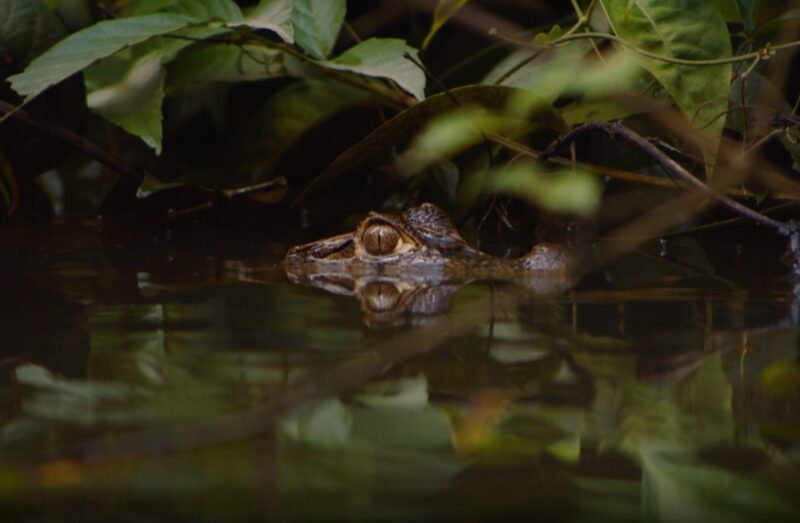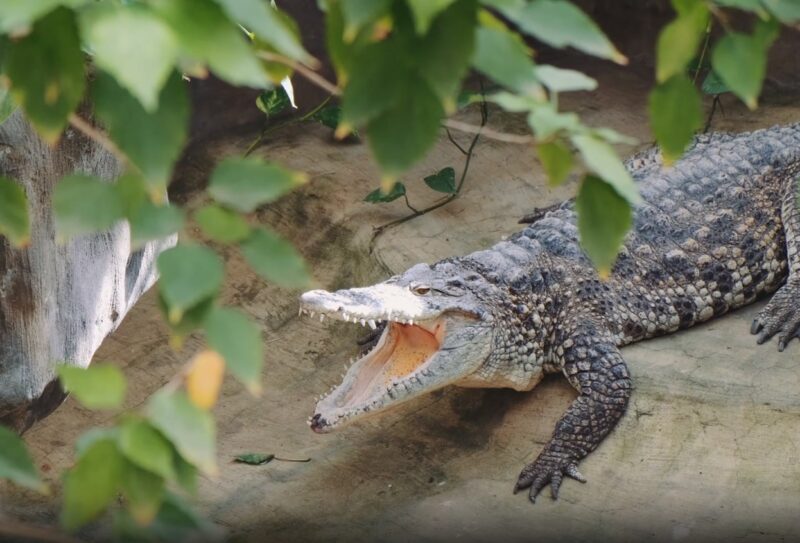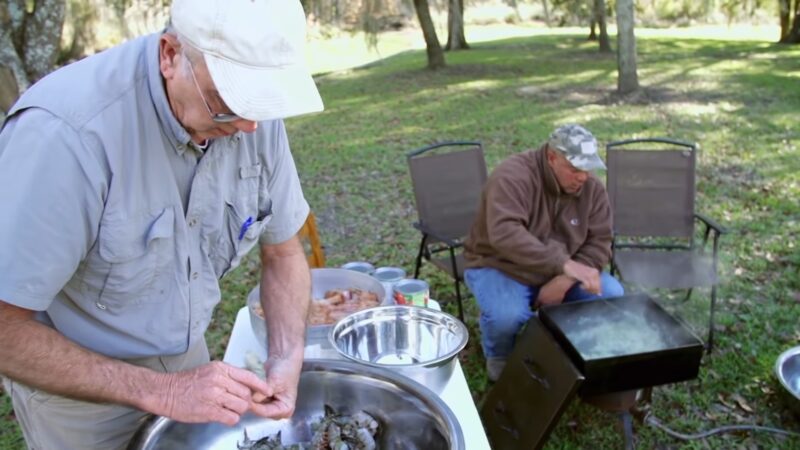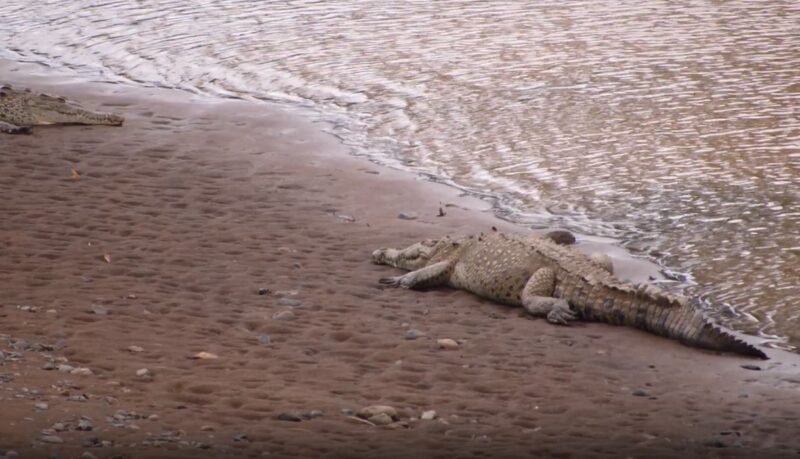The American alligator, a symbol of the bayous, plays a crucial role in maintaining the ecological balance of this rich and diverse region. The bayous and swamps of Louisiana provide not only a picturesque backdrop to the state’s landscape but also a vital habitat for this animal.
The Bayou Ecosystem
The bayous of Louisiana, characterized by their slow-moving waters and rich vegetation, create a unique ecosystem that supports a myriad of life forms. Alligators, as apex predators, play a pivotal role in maintaining the health and balance of this ecosystem by controlling the populations of other animals and preventing overpopulation of certain species.
In the lush swamps and marshes, alligators find ample food and suitable nesting sites, which are crucial for their reproduction and survival. The bayou provides a sanctuary for these creatures, allowing them to thrive in an environment where they can navigate and hunt efficiently.
Human Impact
Humans have a complex relationship with the alligators of Louisiana. On one hand, alligators benefit from the protection of laws and conservation efforts, while on the other, they face threats from habitat loss, pollution, and climate change.
Louisiana’s wetlands are shrinking at an alarming rate, primarily due to human activities and climate change. This loss of habitat directly impacts the alligator population, reducing the available space for nesting and feeding.
Furthermore, pollution from agricultural runoff and industrial activities can contaminate the water, posing additional threats to alligator health and reproduction.
Estimated Population

Estimating the exact number of alligators in Louisiana is a challenging task due to the vast and inaccessible nature of their habitats. However, researchers and conservationists utilize various methods to gauge the population and ensure its sustainability.
Estimation Techniques
- Spotlight Surveys: Researchers navigate through water bodies at night, using spotlights to locate and count alligator eyes, which reflect light.
- Nest Counts: By counting the number of nests in a given area, scientists can estimate the number of breeding females and, by extension, gain insights into population trends.
- Harvest Data: Information from alligator hunting seasons, such as the number and size of alligators harvested, also provides valuable data for population estimates.
Through these methods, scientists can gather data that helps them estimate the alligator population and assess the health of the species within the state.
Current estimates suggest that Louisiana is home to approximately 1.5 to 2 million alligators, although this number can fluctuate due to various environmental and human factors.
Conservation Efforts
Alligator conservation in Louisiana is a multifaceted effort that involves managing habitats, regulating hunting, and conducting ongoing research to monitor population health and trends.
The Louisiana Department of Wildlife and Fisheries (LDWF) plays a pivotal role in these conservation efforts, implementing regulations and programs designed to safeguard the alligator population.
The American alligator, once on the brink of extinction, has made a remarkable recovery thanks to stringent conservation efforts and sustainable use programs. These programs not only protect alligators but also provide economic benefits to local communities through regulated alligator farming and hunting.
Benefits for the Economy

Louisiana’s alligators are not only ecological treasures but also significant contributors to the local economy. The relationship between humans and alligators in the state is deeply intertwined, with economic, cultural, and ecological threads binding them together.
Alligator Farming
Alligator farming is a thriving industry in Louisiana, contributing substantially to the local economy while also playing a role in conservation efforts. Farmers harvest eggs from the wild, and once the alligators are raised to a certain size, a percentage is returned to the wild, ensuring the sustainability of the population.
The alligator farming industry provides valuable products such as meat and hides, which are in demand both domestically and internationally. Moreover, it offers employment opportunities to local communities, thereby playing a vital role in supporting the regional economy.
Tourism
Alligator tourism, encompassing swamp tours, alligator parks, and other related activities, is a significant draw for visitors to Louisiana. Tourists flock to the state to experience the thrill of seeing these magnificent creatures in their natural habitat, contributing to the thriving tourism industry.
Since Louisiana is very popular for hiking, you should learn more about common habitats to know which spots to avoid. However, it’s imperative that alligator tourism is conducted responsibly to minimize disturbance to the animals and their habitats.
Ethical practices and educational components in tourism activities ensure that visitors understand and respect the alligators and their environment, fostering a sustainable relationship between tourism and conservation.
Main Challenges

Managing a species as prolific and ecologically significant as the alligator is no small feat. Louisiana has experienced both challenges and triumphs in its management of alligator populations, navigating through the complexities of conservation, human-wildlife conflict, and sustainable use.
Human-Alligator Conflict
- Residential Encounters: As human populations expand and encroach upon alligator habitats, encounters between the two become more frequent, necessitating effective management strategies.
- Safety Protocols: Implementing and communicating safety protocols for residents and visitors ensures that human-alligator interactions remain safe and conflict-free.
- Relocation Efforts: In situations where alligators pose a threat or become a nuisance, wildlife officials may relocate them to more suitable habitats away from human dwellings.
Balancing the safety of both humans and alligators is crucial in managing shared spaces. Through education, precautionary measures, and strategic management, a harmonious coexistence can be achieved.
Conservation Success
The American alligator is often hailed as a conservation success story. From the brink of extinction, robust and strategic conservation efforts have brought its populations back to healthy and sustainable levels.
The alligator’s comeback is not only a triumph for the species but also for the ecosystems they inhabit. As apex predators, their presence regulates prey populations and maintains the ecological balance of Louisiana’s wetlands.
The success of alligator conservation demonstrates the profound impact of coordinated conservation efforts and provides a beacon of hope for other endangered species.
Symbolism and Significance

The alligator is not merely an animal; it’s a symbol, deeply embedded in the cultural and natural tapestry of Louisiana. The relationship between alligators and the people of Louisiana is rich, multifaceted, and spans centuries, intertwining fear, respect, and fascination.
More Than a Predator
Alligators are omnipresent in Louisiana’s cultural expressions, from the vibrant tales of the Cajun folklore to the artistic depictions in various forms of media.
They are often portrayed as formidable yet fascinating creatures, reflecting the respect and awe they command in the local populace. In Cajun folklore, alligators often play a prominent role, sometimes as a wise creature offering guidance, and at other times, a symbol of the wild, untamed nature of the bayou.
Their presence in local culture is a testament to their significance and the intricate relationship shared by the people and the environment.
Symbol of Strength and Survival
Alligators symbolize strength, resilience, and survival, mirroring the spirit of Louisiana itself. Their ability to survive, adapt, and thrive in the challenging conditions of the bayou is emblematic of the endurance and vitality of the state and its people.
The alligator, with its prehistoric appearance and formidable presence, also symbolizes timelessness and longevity. It stands as a living testament to the ancient, lush, and wild nature of Louisiana, reminding us of the rich history and ecological wealth embedded in the wetlands.
Prospects and Predictions

Climate Change
Climate change poses a significant threat to alligator populations by altering their habitats and potentially impacting their breeding and feeding. Rising sea levels, increased temperatures, and shifting weather patterns can alter the delicate balance of the bayou ecosystem, affecting its flora and fauna.
The resilience of alligators will be tested in the face of these changes, necessitating adaptive management strategies to safeguard their populations. Conservation efforts will need to evolve, taking into account the changing conditions and implementing strategies to mitigate the impacts of climate change on these iconic creatures.
Potential for Sustainable Coexistence
The future of Louisiana’s alligators hinges on our ability to balance conservation with sustainable use, ensuring that the species continues to thrive while also supporting the ecological, economic, and cultural vitality of the state.
- Adaptive Management: Employing management strategies that can adapt to changing conditions and challenges will be crucial in safeguarding the future of alligator populations.
- Community Involvement: Engaging local communities in conservation efforts, ensuring that they are stakeholders in the management of alligator populations.
- Education and Awareness: Raising awareness about the significance of alligators and the role they play in maintaining ecological balance, ensuring that future generations understand and respect these magnificent creatures.
FAQs
What is the average lifespan of an alligator in the Louisiana bayous?
In the wild, American alligators can live for about 35-50 years, although this can vary depending on factors like food availability, habitat conditions, and absence of disease. In captivity, where threats are minimized, alligators can live up to 60-80 years.
How do alligators in Louisiana cope with colder winter temperatures?
Alligators are ectothermic, meaning they rely on external sources to regulate their body temperature. During colder months, alligators in Louisiana enter a state of brumation, which is similar to hibernation. They seek refuge in “gator holes” (dug-out depressions) or burrows and become relatively inactive, slowing their metabolism until temperatures rise again.
What are some traditional dishes in Louisiana that use alligator meat?

Alligator meat is featured in various traditional Louisiana dishes, such as alligator étouffée, fried alligator bites, and alligator sauce piquante. It’s often celebrated for its unique, slightly sweet flavor and can be prepared in various ways, reflecting the rich culinary diversity of the region.
What role do alligators play in managing rodent populations in Louisiana?
Alligators are opportunistic feeders and consume a variety of prey, including rodents like rats and nutria. By preying on these animals, alligators help control rodent populations, which can be beneficial in reducing agricultural pests and minimizing the spread of diseases associated with these creatures. This predatory role is a key aspect of the alligator’s contribution to maintaining ecological balance in their habitats.
Last Words
From being a vital component of the local economy to symbolizing the wild, untamed spirit of the bayou, alligators play a pivotal role in both the natural and human realms.
Their future, influenced by conservation efforts, climate change, and human activities, reflects the broader narrative of environmental stewardship and sustainable coexistence.
